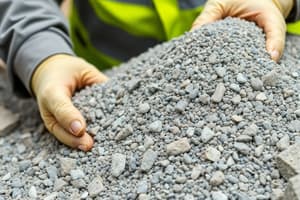Podcast
Questions and Answers
What is the primary purpose of a sieve set in materials testing?
What is the primary purpose of a sieve set in materials testing?
- Measuring the viscosity of fluids
- Testing the compressive strength of concrete
- Measuring the density of materials
- Determining the particle size distribution of aggregates (correct)
A graduated beaker is typically used for measuring precise volumes of liquids.
A graduated beaker is typically used for measuring precise volumes of liquids.
True (A)
What is the purpose of the slump cone test in concrete technology?
What is the purpose of the slump cone test in concrete technology?
The slump cone test is used to assess the consistency and workability of fresh concrete, making it easier to pour and place.
Concrete cube molds are primarily used to create specimens for ______ testing.
Concrete cube molds are primarily used to create specimens for ______ testing.
Match the following types of beakers with their descriptions:
Match the following types of beakers with their descriptions:
Which of the following is NOT a standard IS sieve size?
Which of the following is NOT a standard IS sieve size?
Plastic cylinder molds are typically reusable in concrete testing.
Plastic cylinder molds are typically reusable in concrete testing.
What is the minimum weight of the sample required for sieve analysis, as mentioned in the provided text?
What is the minimum weight of the sample required for sieve analysis, as mentioned in the provided text?
Concrete cylinders are typically cast for standard size and allowed to cure for ______ days.
Concrete cylinders are typically cast for standard size and allowed to cure for ______ days.
Which of the following are types of pressure gauges?
Which of the following are types of pressure gauges?
The Load indicating Devices have a single dial that indicates both range and load values.
The Load indicating Devices have a single dial that indicates both range and load values.
What are the dimensions of the largest molds mentioned in the text?
What are the dimensions of the largest molds mentioned in the text?
The compression test on a concrete cylinder is performed horizontally.
The compression test on a concrete cylinder is performed horizontally.
A concrete mixer is a machine used to mix concrete ingredients such as cement, aggregates, and ______ to create a uniform mixture.
A concrete mixer is a machine used to mix concrete ingredients such as cement, aggregates, and ______ to create a uniform mixture.
What is the primary purpose of the pad caps used in the compression test?
What is the primary purpose of the pad caps used in the compression test?
What is the purpose of a tamping rod in construction?
What is the purpose of a tamping rod in construction?
Before applying the load, it's essential to ensure that the loading platforms touch the ______ of the cylinder.
Before applying the load, it's essential to ensure that the loading platforms touch the ______ of the cylinder.
Match the following construction tools with their primary functions:
Match the following construction tools with their primary functions:
What is the standard rate of load application in a compression test on a concrete cylinder?
What is the standard rate of load application in a compression test on a concrete cylinder?
Match the components of the Universal Testing Machine with their descriptions:
Match the components of the Universal Testing Machine with their descriptions:
What is the primary function of the return valve in the hydraulic control devices?
What is the primary function of the return valve in the hydraulic control devices?
Flashcards
Load Indicating Devices
Load Indicating Devices
Instruments that show the load on a specimen using a pointer and dial.
Mobile Concrete Mixers
Mobile Concrete Mixers
Concrete mixers that can be moved to various locations for mixing purposes.
Standard Pressure Gauge
Standard Pressure Gauge
A device that measures pressure in systems, typically using a dial display.
Surface Vibrators
Surface Vibrators
Signup and view all the flashcards
Vicat Apparatus
Vicat Apparatus
Signup and view all the flashcards
Sieve Set
Sieve Set
Signup and view all the flashcards
Balance
Balance
Signup and view all the flashcards
Graduated Beaker
Graduated Beaker
Signup and view all the flashcards
Slump Cone
Slump Cone
Signup and view all the flashcards
Cube Molds
Cube Molds
Signup and view all the flashcards
Cylinder Molds
Cylinder Molds
Signup and view all the flashcards
Flat Beakers
Flat Beakers
Signup and view all the flashcards
Tall Beakers
Tall Beakers
Signup and view all the flashcards
Concrete Cylinder Testing
Concrete Cylinder Testing
Signup and view all the flashcards
Curing Period
Curing Period
Signup and view all the flashcards
Compression Testing Machine
Compression Testing Machine
Signup and view all the flashcards
Loading Rate
Loading Rate
Signup and view all the flashcards
Maximum Load Recorded
Maximum Load Recorded
Signup and view all the flashcards
Beam Moulds
Beam Moulds
Signup and view all the flashcards
Universal Testing Machine
Universal Testing Machine
Signup and view all the flashcards
Hydraulic Control Devices
Hydraulic Control Devices
Signup and view all the flashcards
Study Notes
Construction Materials and Testing - Chapter 2
-
Introduction: Material quality is critical in construction, impacting success or failure. Materials testing ensures final products meet safety and quality standards, assessing characteristics under various conditions. Testing reasons include safety, cost, and ensuring suitability for intended use.
-
Materials Testing: Involves examining composition, physical structure, and chemical properties. Common tests include specific gravity, unit weight, density, compression strength, flexural strength, tensile strength, elasticity, permeability, thermal expansion, drying shrinkage, and heat capacity.
-
Specific Objectives: Students should be able to list and explain the various apparatus and equipment used in material testing, along with their functions.
-
Duration: The chapter/lesson on familiarization with apparatus and equipment takes 6 hours, including 5 hours of discussion and an assessment.
1. Sieve Set
-
Purpose: Used to separate wanted elements from unwanted matter in samples like aggregates, sand, and other soil particles to analyze the particle size distribution.
-
Apparatus: Comprehensive set of sieves with standardized sizes; from 80mm down to 75μm (specific measurements listed)..
-
Balance/Scale: A balance with 0.1% accuracy is required to measure the test sample's weight accurately.
-
Procedure: Sample preparation, sieving through sieves, weighing collected material in each sieve after sieving.
-
Reporting: Cumulative percentage by weight of total sample; percentage of sample retained on each sieve, and recorded graphically on a semi-log graph
2. Balance
-
Purpose: Used to determine the specific gravity (ratio of density to water density) of cured materials. (concrete, asphalt)
-
Types: Various scales are available, including bench, platform, and wheeled types.
3. Graduated Beaker
-
Purpose: Used for preparing solutions, decanting fluids, holding waste fluids, and performing simple reactions.
-
Types: The different types include "low-form" and "tall-form" described by the ratio of height to diameter. "Tall-form" beakers are often called Berzelius beakers.
4. Calculator
- Purpose: For calculations related to testing results.
5. Slump Cone
-
Purpose: Used for measuring the consistency of fresh concrete (workability); specifically how it flows.
-
Procedure: Using a standard mold (cone), the concrete is placed and tamped in stages, and the subsidence is measured.
-
Results: Recorded in mm (to nearest 5mm or 10mm)
6. Various Molds
- Cube Molds: Used to test concrete's compressive strength.
- Cylinder Molds: Used to measure concrete compressive strength.
7. Hydrometer
- Purpose: Used to measure the specific gravity (relative density) of liquids.
- Operation: Lowered into liquid until floating freely; the reading where the liquid touches the stem indicates the specific gravity.
8. Universal Testing Machine (UTM)
-
Purpose: For tensile, compressive, or transverse stress testing on specimens (including concrete, metal). This equipment can also be used for Brinell hardness, ductility, and other property testing
-
Parts and Functions: Detailed descriptions of the two main parts, the loading unit and the control panel. The loading unit has a robust base, cylinder, and piston, operated by screws. The control panel has the hydraulic power unit, load measuring unit, and control devices.
9. Concrete Mixer
-
Purpose: Used for mixing concrete thoroughly.
-
Types: Mobile concrete mixers (for multiple use) vs stationary concrete mixers (fixed position)
10. Pressure Gauge
- Purpose: Used to measure pressure.
- Types: Standard pressure gauges, integrated pressure gauges, flange pressure gauges, red-green pressure gauges, plug-in pressure gauges.
11. Tamping Rod
- Purpose: Used to tamp fresh concrete or materials.
12. Thermometer
- Purpose: To measure and indicate temperature
13. Vibrator
- Types: Immersion, external, and surface vibrators, designed for compaction; each of these are detailed.
14. Vicat Apparatus
- Purpose: Determining the consistency, initial setting time, and final setting time of cement.
15. Electric Oven
- Purpose: High-forced volume, uniform temperature ovens for annealing, curing, and drying.
16. Stop Watch
- Purpose: Provides timing measurements for testing processes.
17. Funnels
- Purpose: Transferring materials without compromising the substance's quality or harming the scale.
18. Wire Basket
- Purpose: Specific gravity and water absorption testing for aggregates(testing).
19. Hydraulic Jack
- Purpose: Used to lift heavy loads that are not manageable by hand, conventional methods.
Studying That Suits You
Use AI to generate personalized quizzes and flashcards to suit your learning preferences.




